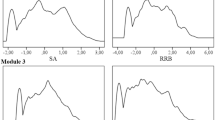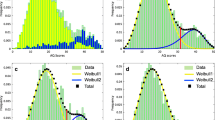Abstract
The latent class structure of autism symptoms from the time of diagnosis to age 6 years was examined in a sample of 280 children with autism spectrum disorder. Factor mixture modeling was performed on 26 algorithm items from the Autism Diagnostic Interview - Revised at diagnosis (Time 1) and again at age 6 (Time 2). At Time 1, a “2-factor/3-class” model provided the best fit to the data. At Time 2, a “2-factor/2-class” model provided the best fit to the data. Longitudinal (repeated measures) analysis of variance showed that the “2-factor/3-class” model derived at the time of diagnosis allows for the identification of a subgroup of children (9 % of sample) who exhibit notable reduction in symptom severity.





Similar content being viewed by others
References
Achenbach, T. M., & Rescorla, L. A. (2000). Manual for ASEBA preschool forms and profiles. Burlington, VT: University of Vermont, Research Center for Children, Youth, and Families.
American Psychiatric Association. (1994). Diagnostic and statistical manual of mental disorders (4th ed.). Washington, DC: American Psychiatric Association.
American Psychiatric Association. (2000). Diagnostic and statistical manual of mental disorders (4th ed., Text Revision). Washington, DC: American Psychiatric Association.
American Psychiatric Association. (2013). Diagnostic and statistical manual of mental disorders (5th ed.). Arlington, VA: American Psychiatric Publishing.
Bodfish, J. W., Symons, F., & Lewis, M. (1999). The repetitive behavior scale: Test manual. Morganton: Western Carolina Center Research Reports.
Bodfish, J. W., Symons, F. J., Parker, D. E., & Lewis, M. H. (2000). Varieties in repetitive behavior in autism. Journal of Autism and Developmental Disorders, 30, 237–243.
Constantino, J. N., & Gruber, C. P. (2005). Social responsiveness scale. Los Angeles: Western Psychological Services.
Frazier, T. W., Youngstrom, E. A., Sinclair, L., Kubu, C. S., Law, P., Rezai, A., et al. (2010). Autism spectrum disorders as a qualitatively distinct category from typical behavior in a large, clinically ascertained sample. Assessment, 17, 308–320.
Frazier, T. W., Youngstrom, E. A., Speer, L., Embacher, R., Law, P., Constantino, J., et al. (2012). Validation of proposed DSM-5 criteria for autism spectrum disorder. Journal of the American Academy of Child and Adolescent Psychiatry, 51, 28–40.
Georgiades, S., Szatmari, P., Boyle, M., Hanna, S., Duku, E., Zwaigenbaum, L., et al. (2013a). Investigating phenotypic heterogeneity in children with autism spectrum disorder: A factor mixture modeling approach. Journal of Child Psychology and Psychiatry, 54, 206–215.
Georgiades, S., Szatmari, P., & Boyle, M. (2013b). Editorial: The importance of studying heterogeneity in autism. Neuropsychiatry: Future Medicine, 3(2), 123–125.
Geschwind, D. (2011). Genetics of autism spectrum disorders. Trends in Cognitive Sciences, 15, 409–416.
Gotham, K., Pickles, A., & Lord, C. (2009). Standardizing ADOS scores for a measure of severity in autism spectrum disorders. Journal of Autism and Developmental Disorders, 39, 693–705.
Happe, F. (2011). Criteria, categories, and continua: Autism and related disorders in DSM-5. Journal of the American Academy of Child and Adolescent Psychiatry, 50, 540–542.
Huerta, M., Bishop, S. L., Duncan, A., Hus, V., & Lord, C. (2012). Application of DSM-5 criteria for autism spectrum disorder to three samples of children with DSM-IV diagnoses of pervasive developmental disorders. American Journal of Psychiatry, 169, 1056–1064.
Lord, C., Risi, S., Lambrecht, L., Cook, E. H., Jr, Leventhal, B. L., DiLavore, P. C., et al. (2000). The autism diagnostic observation schedule-generic: A standard measure of social and communicative deficits associated with the spectrum of autism. Journal of Autism and Developmental Disorders, 30, 205–223.
Lord, C., & Jones, R. M. (2012). Annual research review: Rethinking the classification of autism spectrum disorders. Journal of Child Psychology and Psychiatry, 53, 490–509.
Lubke, G. H., & Muthen, B. O. (2005). Investigating population heterogeneity with factor mixture models. Psychological Methods, 10, 21–39.
Mandell, D. (2011). The heterogeneity in clinical presentation among individuals on the autism spectrum is a remarkably puzzling facet of this set of disorders. Autism: The International Journal of Research and Practice, 15(3), 259–261.
Muthen, B. (2004). Latent variable analysis: Growth mixture modeling and related techniques for longitudinal data. In D. Kaplan (Ed.), Handbook of quantitative methodology for the social sciences (pp. 345–368). Thousand Oaks: Sage.
Muthén, L.K., & Muthén, B. (2008). Mplus 5.1 for windows. Los Angeles, CA: Author.
Nylund, K. L., Asparouhov, T., & Muthen, B. (2007). Deciding on the number of classes in latent class analysis and growth mixture modeling. A Monte Carlo simulation study. Structural Equation Modeling, 14, 535–569.
Ozonoff, S. (2012). Editorial perspective: autism spectrum disorders in DSM-5—an historical perspective and the need for change. Journal of Child Psychology and Psychiatry, 53, 1092–1094.
Pandolfi, V., Magyar, C. I., & Dill, C. A. (2009). Confirmatory factor analysis of the child behavior checklist 1.5-5 in a sample of children with autism spectrum disorders. Journal of Autism and Developmental Disorders, 39, 986–995.
Rutter, M. (2011). Research review: Child psychiatric diagnosis and classification: Concepts, findings, challenges and potential. Journal of Child Psychology and Psychiatry, 52, 647–660.
Rutter, M. (2012). Changing concepts and findings on autism. Journal of Autism and Developmental Disorders,. doi:10.1007/s10803-012-1713-7.
Rutter, M., LeCouteur, A., & Lord, C. (2003). ADI-R: The autism diagnostic interview-revised. Los Angeles, CA: Western Psychological Services.
Sparrow, S. S., Cicchetti, D. V., & Balla, D. A. (2005). Vineland adaptive behavior scales: Second Edition (Vineland II), survey interview form/caregiver rating form. Livonia, MN: Pearson Assessments.
Szatmari, P. (2011). New recommendations on autism spectrum disorder. BMJ, 342, d2456.
Walton, K. E., Ormel, J., & Krueger, R. F. (2011). The dimensional nature of externalizing behaviors in adolescence: Evidence from a direct comparison of categorical, dimensional, and hybrid models. Journal of Abnormal Child Psychology, 39, 553–561.
Wiggins, L. D., Robins, D. L., Adamson, L. B., Bakeman, R., & Henrich, C. (2011). Support for a dimensional view of autism spectrum disorders in toddlers. Journal of Autism and Developmental Disorders, 42, 191–200.
Acknowledgments
This study was supported by the Canadian Institutes of Health Research, Autism Speaks, the Government of British Columbia, the Alberta Innovates Health Solutions, and the Sinneave Family Foundation. Dr. Stelios Georgiades is supported by an Autism Research Training (ART) fellowship by the Canadian Institutes of Health Research. The authors thank all the families who participate in the Pathways in ASD study. The authors also acknowledge the members of the Pathways in ASD Study Team. Parts of this paper have been presented at the International Meeting for Autism Research (Spain, 2013). An earlier version of the paper was included as a chapter in a dissertation by Dr. Georgiades (PhD degree in Health Research Methodology, McMaster University, Ontario, Canada).
Author information
Authors and Affiliations
Consortia
Corresponding author
Electronic supplementary material
Below is the link to the electronic supplementary material.
Rights and permissions
About this article
Cite this article
Georgiades, S., Boyle, M., Szatmari, P. et al. Modeling the Phenotypic Architecture of Autism Symptoms from Time of Diagnosis to Age 6. J Autism Dev Disord 44, 3045–3055 (2014). https://doi.org/10.1007/s10803-014-2167-x
Published:
Issue Date:
DOI: https://doi.org/10.1007/s10803-014-2167-x




